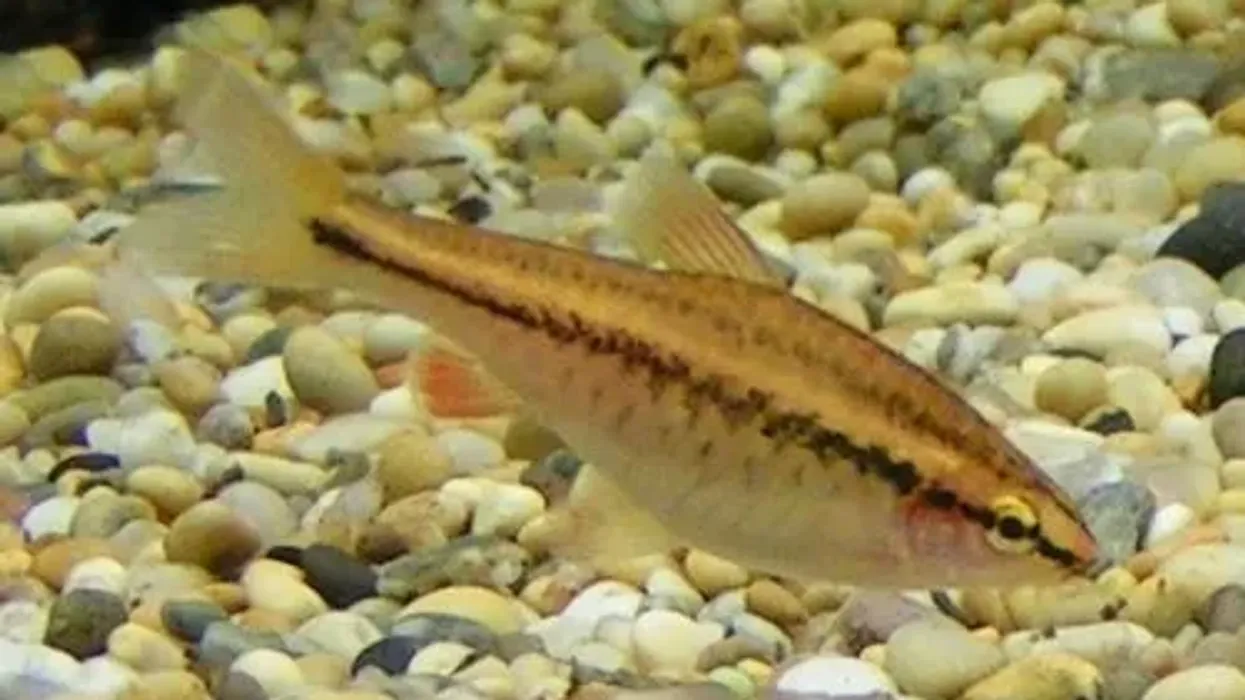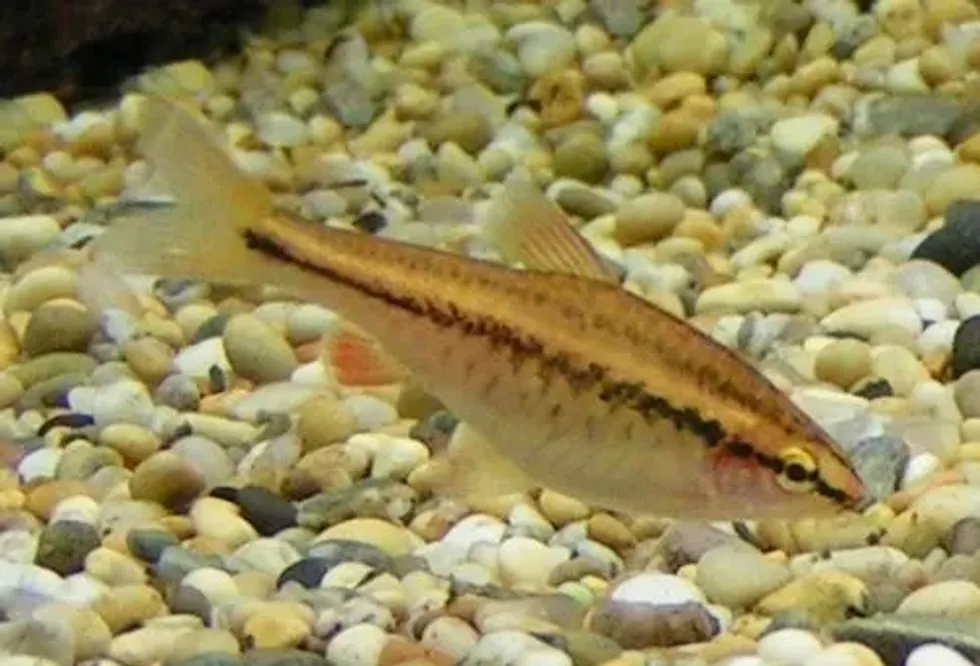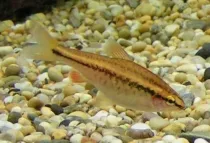The Cherry barb (Puntius titteya) is one of the favorite aquarium fishes of many people. It's a small-sized hardy fish that can grow about 1.6-2 in (4.1-5.1 cm) long, and it attains this length only about two to three months after its birth.
Cherry barbs can come in many shades of red, but when it comes to cherry barb male vs. female, there are a few things that help us tell them apart.
Males and females look different from one another. The female has a lighter-colored body with whitish hues, and the male has a brighter red-colored body.
The male cherry barb has a slender and larger body in comparison to the female, with the female cherry barb having0 a fuller and smaller body.
But first, you need to know that the required minimum tank size of this freshwater fish is 30 gal (113.6 l), and it's going to need tank mates. Some perfect cherry barb tank mates are celestial pearl danios, glass catfish, or tetras.
If you're thinking about breeding more of them, then you will need at least two more tanks.
Most importantly, cherry barbs do not give birth to live babies. They lay eggs, and when the eggs hatch, the larvae come out, and then these larvae become fry.
Read on to get more information on cherry barbs before going to get fish for your aquarium next time. If you like this article, then also check out neon tetra and teira batfish.
Cherry Barb Interesting Facts
What type of animal is a cherry barb?
The Cherry barb (Puntius titteya) is a kind of fish. It's a type of freshwater fish that is even kept as pets.
What class of animal does a cherry barb belong to?
The Cherry barb belongs to the class Actinopterygii of animals.
How many cherry barbs are there in the world?
The exact number in terms of the population of this freshwater fish is not known. The fishes are mainly native to Sri Lanka but later have been introduced in other places too.
Neither their numbers in Sri Lanka are known, nor how many fishes are living outside their native place is known. Some are even kept in aquariums around the world as pets. Hence, calculating a proper number becomes pretty hard.
Where does a cherry barb live?
Cherry barbs are native to Sri Lanka. They have been mainly found in the southwestern part of the country. They can be seen in Gampaha, Ratnapura, Matara, Kalutara, Colombo, Kegalle and in the city of Galle.
They have later been introduced in Colombia and Mexico. These fishes are also farmed for people to keep in their homes as pets. So, they also live in homes all around the world.
What is a cherry barb's habitat?
Cherry barb is mainly freshwater fish. Their natural habitat includes rivers and streams around the plains in Sri Lanka.
They mainly prefer to live in clear and shallow waters that are shaded and slow-moving habitats. Even in a freshwater aquarium, their perfect environment is a tank that is full of growing aquatic plants, so there's much shade and density in the tank.
Some clear area in the tank where they can swim is also needed. They are native to tropical climates, so the water temperature, water conditions, and pH of the tank should be set according to that.
Who do cherry barbs live with?
Cherry barbs are schooling fish in nature, so they tend to stay together. In the wild, these fishes stay in groups of many.
In captivity, it's advisable to at least keep them in small fish groups, or else they may act out of their natural temperament. Peaceful fish like cherry barb will become shyer and stressed.
When you are keeping them as pets, a proper ratio of the fishes in terms of gender should also be followed, which is one male per two female fishes.
How long does a cherry barb live?
The cherry barb's lifespan is about four years, but if taken care of properly, it can live about seven years long.
How do they reproduce?
The exact cherry barb breeding season is not known, but an easy way to figure out the time is by looking at the color of the fishes. The males are usually brighter in color than the females, but at the time of breeding, their color then becomes even brighter than usual.
The males might show aggressive nature at this time.
The females lay about 226-284 eggs, and they usually scatter these eggs around the vegetation.
Hence, having enough plants in your tank is necessary at this time. Many times the adult fishes eat the eggs, so it's important to keep a separate smaller tank to keep the eggs till they hatch and are ready to fend for themselves.
The female swells up when the time for breeding approaches, and some people mistake it thinking that she is pregnant. But pregnant cherry barb fish does not exist as they just lay eggs.
After laying eggs, the females become weak, but the aggressiveness might still be there in the males, so having a separate tank for the females until they regain their strength might also do them some good.
The eggs hatch in around one to two days, and they take a few more days to swim freely in the water.
The fry would need to be fed little amounts of food and tiny-sized or liquid food. It takes about two months for the cherry barb fry to grow into adult size.
What is their conservation status?
According to the International Union for Conservation of Nature Red List, the conservation status of these fishes is Vulnerable. The fishes only live in a few limited areas, and even in these areas, their population is threatened.
The species is mostly threatened by the ornamental fish trade. About 2780 fishes were released in 48 different countries other than their native place, but 98% of them got collected within only a few years.
The trade has increased manifolds in today's date owing to the increasing popularity of the fish. Many of their lives are threatened due to the introduction of predatory fishes into their natural habitat.
Sometimes these fishes turn out to be invasive and eat their way through cherry barbs.
Another reason is habitat loss due to the plantation of hydropower projects and water pollution. In many wet regions in Sri Lanka, where the population of these fishes thrives, there have been made as many as 110 or more hydraulic projects.
These projects can destroy freshwater habitats and dry out the water sources. Not many steps have been taken to control the population around their native place, but exporting of these fishes has been restricted and banned in some places.
Cherry Barb Fun Facts
What do cherry barbs look like?
Cherry barbs have elongated bodies. They have just one dorsal fin and a forked tail. The fishes have slender bodies, but the males and females have different body features.
Females look a bit fuller than males. The color of their skin usually ranges from light red to bright maroon. The females are rather lighter in color than the males.
They become even paler during the breeding season. A black stripe can be seen running from their mouth to their tail. It's more visible in females due to their whitish scales.

How cute are they?
These fishes can seem extremely cute owing to their tiny size and the beautiful color of their scales. They are also peaceful fish and like to stay in groups, which only adds to their cuteness.
How do they communicate?
These fishes can hear, but they also rely on the sense of vibration around them to get an idea of their surroundings.
How big is a cherry barb?
The average cherry barb size is about 1.6-2 in (4.1-5.1 cm) long. The males are a bit larger than the female cherry barbs. The largest among the barb fishes is the tinfoil barb, and cherry barbs look pretty small compared to them. A fully adult tinfoil barb can grow up to be almost 13 in(33 cm) long.
How fast can a cherry barb swim?
The speed at which cherry barbs swim is not known. Their swimming and any other movement have only been observed in captivity and in the aquariums, these fishes move only according to the space of the fish tank, and they swim slowly.
How much does a cherry barb weigh?
Cherry barbs are small-sized freshwater fishes. They are widely kept as pets. They weigh only about 12.3-26.2 grains (0.8-1.7 g).
What are their male and female names of the species?
There are no specific names for the male or female gender of this species.
What would you call a baby cherry barb?
After the eggs of the fish hatch, the babies are called larvae. When they grow bigger but are still not adults, those young fishes are called fry.
What do they eat?
Cherry barbs are omnivorous in nature, and the ones living in the wild eat about anything. They can eat dipterans, detritus, diatoms, algae, zooplankton, other animal matters, and plant matters.
The ones that are kept in captivity, i.e. in aquariums, can be given live or frozen food, pellets, and flakes.
They should be given high-quality fish food, and as supplements, they can be given brine shrimp, vegetables, daphnia, or blood worms. The fry should be given liquid food, micro worms, or vinegar eels. The cherry barb feeding habit should average two to three meals per day.
Generally, give them the amount of food that they will be able to eat within three minutes, but adjust the amount by seeing how much they eat every day. The adults sometimes can be seen eating the eggs of their fish too.
Are they eaten by humans?
Generally, barb fishes can be eaten. They are rather sweet in taste, but in the case of cherry barbs, these fishes are not eaten.
This may be due to it being small fish or due to the unavailability. The population of these fishes is vulnerable, so they are not found in abundance to be eaten but are only available as pets.
Would they make a good pet?
These little fish are great as a pet. Cherry barbs can be perfect for even beginners who want to keep fish as pets as cherry barb care is easy.
They need minimal maintenance, and their vibrant color adds beauty to the tank. The fishes require an environment similar to that of a tropical climate as they primarily come from Sri Lanka.
The minimum tank size should be at least 30 gal (113.6 l), and they should be kept in groups, as these fishes are strictly schooling fishes. They require enough vegetation in order to hide and lay the eggs on, but they also need enough clear space for free swimming.
A tank full of cherry barb temperature should be somewhere around 73.4-80.6 F (23-27 C), while the pH should be about six to eight.
They prefer to stay in rather still or slow-moving water, so water movement in your tank should be at a minimum. The water hardness should be soft to medium; it should be around 4-15 DH.
Dirty tank water and improper water parameters cause bacterial diseases in the fishes, so water changes need to be made regularly. The water changes will need to be made at least once a month.
Some common fish diseases are ich and fin rot, so keep an eye out for that. If water parameters are properly met, then these fishes can stay as your companions for seven long years.
Did you know...
Male cherry barbs don't need to be there when the female cherry barbs are laying eggs, and in fact, after scattering the eggs everywhere, these fishes don't take care of the eggs, and they leave them be, which can sometimes result in a low survival rate for the eggs.
One of the most common diseases to which cherry barbs can fall victims is neon tetra disease. The name might suggest that the disease only occurs in neon tetras, but it's a parasitic disease that is known to spread to any of the aquarium fishes.
You first have to identify the disease in your fish in order to treat them.
The symptoms may include - fin rot, the fish may start to lose its color (sometimes in a single place), or restlessness. Additionally, cysts may appear in many parts of the body, so the body might become lumpy, and your fish might face difficulty in swimming.
A few different kinds of cherry barbs can be seen, like, albino cherry barb, veiltail cherry barb, or longfin cherry barb. These fishes are only a little different than the regular cherry barbs.
For example, the body color of the albino cherry barb fish is pink to cream, and their eyes are also pink. These fishes don't usually have a black stripe running on the middle of their bodies.
How many cherry barbs should be kept together?
Cherry barbs are schooling fish that should not be kept alone.
They stay in groups in the wild, and they should be kept in groups in captivity too.
If you keep cherry barbs alone, they might get anxious or timid, therefore, at least five of them should be kept in a tank at all times. Five gallons of water per fish should be considered when determining the size of the tank.
Just because the males are brighter in color and make for wonderful sight, you should not just keep males together in one place as they might fight among themselves.
The perfect ratio in terms of gender would be two female fish for each male fish as male fishes tend to get aggressive at the time of breeding.
If there are more females, one male won't bother one female, which will keep the health of every fish at a normal level.
You might also need one or two more tanks if you want to breed them, and in that case, don't keep the adult fishes together with the eggs as they tend to eat the eggs, and don't keep the females together with the males as the males still remain aggressive, but the females become weak after laying eggs.
These fishes are peaceful in nature, so if you're thinking about keeping other species of fishes along with these fishes, then they should be of the same nature.
Thus, the perfect cherry barb tank mates would be celestial Pearl danios, glass catfish, or tetras.
What are some other names for a cherry barb?
This little fish is also called by a few other names, like, red cherry barb or crimson carplet.
Here at Kidadl, we have carefully created lots of interesting family-friendly animal facts for everyone to discover! Learn more about some other fish including haddock, or turbot.
You can even occupy yourself at home by drawing one on our goldfish coloring pages.









